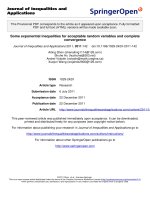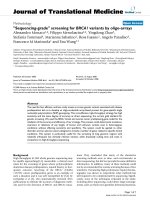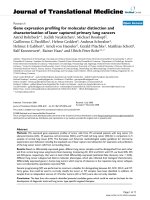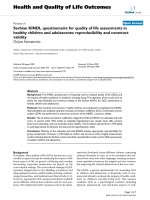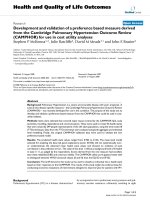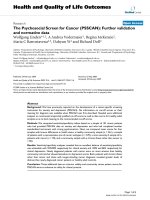báo cáo hóa học: " Data processing techniques for a wireless data transmission application via mud" ppt
Bạn đang xem bản rút gọn của tài liệu. Xem và tải ngay bản đầy đủ của tài liệu tại đây (280.16 KB, 8 trang )
RESEARC H Open Access
Data processing techniques for a wireless data
transmission application via mud
Qingjie Zhao
*
, Baojun Zhang and Wei Wang
Abstract
The data measured by well bottom sensors can be transmitted to the surface through the drilling mud during oil
drilling operations. This article introduces a data processing scheme for a wireless data transmission application via
mud. The detailed signal processing procedure is given, and several data processing techniques used are
discussed, mainly including data encoding and signal integrating method, signal filtering, data storage and manage
method, peak detection, signal recognition, and data decoding method. The article uses M pulses in N slots to
encode the values of actual parameters. A two step filtering method and a dynamic data storing and managing
method are proposed. A mix peak detection method is utilized to find the position of a pulse by combining
threshold method and neighbor comparison method. These techniques have been successfully used in an oil well
drilling operation.
Keywords: Signal proce ssing, data encoding and decoding, data transmission
Introduction
When drilling oil wells, especially in directional drilling,
it is very helpful to utilize a kind of measurement-while-
drilling system to provide real-time monitoring to the
direction of a bottom-hole assembly, the angle of the
hole, the gamma radiation from f ormations, and some
other physical parameters. However, it is difficult to
transmit the data measured from down-hole environ-
ments with thousands of meters depth, high temperature,
and high pressure. At present, tra nsmitting the data
through cables may not be a good method because this
will disturb ordinary drilling operations and the cables
may be eroded under the rigorous down-hole conditions.
Mud pulse telemetry [1] is one of feasible wireless meth-
ods used for oil drilling operations, mainly for the control
and transmission of the data from a w ell bottom to the
surface during drilling operations. Drilling mud is added
to the wellbore to facilitate the drilling process by sus-
pending cuttings, controlling pressure, stabilizing exposed
rock, providing buoyancy, and cooling and lubricating.
Transmitting the data from a well bottom to the surface is
an another function of drilling mud, which can help
drilling operations but give less influence to the drilling
process.
Although there are some reports [2] that introduce
measurement-while-drilling tools, and enormous litera-
tures on signal processing in other fields such as geophy-
sics, medical imaging, vibrat ion studies, etc., however,
there are few literatures that i ntroduce data or signa l
processing techniques for a measurement-while-drilling
system in petroleum engineering. A measurement-while-
drilling system based on a microcontroller is developed
in [3]. The data come from different down-hole sensors
such as three-axe accelerometers, magnetometers,
gamma-ray detector, resistivity detector, and other
sensors. Ledroz et al. [4] and Pecht et al. [5] use a fiber-
optic-gyroscope-based inertial measurement unit in gyro-
scope aims. Wavelet transform in [6] is used to get rid of
high-frequency noise from the contaminated data. In [7]
and [8], a limited impulse response low-pass filter is used
as a DC (direct current) estimator, and a band-p ass filter
is used to eliminate the large out-of-band noise compo-
nents caused by the mud pumps, and at last a zero mean
signal is acquired. In [9], we propose a two-step filtering
method in which a dynamic part mean filtering algorithm
is proposed to separate the direct current components
and a windowed limited impulse response algorithm is
used to filter out the high-frequency noise.
* Correspondence:
Beijing Lab of Intelligent Information Technology, School of Computer
Science, Beijing Institute of Technology, Beijing, 100081, China
Zhao et al. EURASIP Journal on Advances in Signal Processing 2011, 2011:45
/>© 2011 Zhao et a l; licensee Springer. This is an Open Access article distributed under the terms of the Creative Commons Attribution
License ( which permits unrestricted use, distribution, and reproduc tion in any medium,
provided the original work is properly cited.
In this article, we introduce several data processing
techniques used in a mud pulse telemetry system, mainly
discuss signal encoding, fil tering, data storing and mana-
ging, signal recognition and decoding methods. Although
the scheme using M pulses in N slots to encode values is
not a new idea, our contributions mostly lie in giving
detail ed signal flow, formulating the relation between the
maximal number of codes and M/N,proposingatwo
step filtering method, a dynamic data storing and mana-
ging method, and a mix peak detection method.
The rest of this paper is organized as follows. ‘Principle
of mud pulse telemetry’ section describes the principle of
mud pulse telemetry. ‘Down-hole data processing’ section
introduces the data encoding method and the combined
sig nal components. ‘Surface data processing’ section dis-
cusses surface data processing techniques inc luding fil-
tering, sequence recognition and decoding. Finally, a
brief conclusion is presented in ‘Conclusion’ section.
Principle of mud pulse telemetry
The system designed includes two parts: the down-ho le
part and the sur face part. The down-hole part modulates
the data from both down-hole sensors and the embedded
computing module, creating mud pressure pulses t o
carry encoded down-hole data to the surface. A t the sur-
face, the mud pressure pulses are detected, transformed,
processed, and decoded.
Down-hole sensors include three magnetometers and
three accelerometers fixed tri-axially to measure the
compass direction of the bottom-hole assembly and the
angle of the hole which are then used to calculate the tra-
jectory of the well along with depth. A gamma-ray detec-
tor measures naturally occurring gamma radiation from
formations encountered to estimate stratigraphic forma-
tion. A resistivity dete ctor is to help rec ognize rock, oil
or water. These data together with those of down-hole
temperature, generator’s rotate speed and battery ’ svol-
tage are gathered, converted and formatted for transmis-
sion, and stored in the embedded computing module.
The embedded c omputing module encodes data into
pulses and controls the pulser operations. The pulser
generates electrical power and restricts the mud flow to
create pressure pulses with a valve in the stream of mud
to be controlled open or close. The pressure in the pipe
is caused to rise or fall respectively, and pressure waves
are generated. The modulated data are then transferred
to the surface with drilling mud pulses.
The surface part, which receives and decodes the data
from the down-hole, includes a mud pressure sensor, an
interface box, computers, and displays for drilling opera-
tors or technicians. At the surface, the pressure sensor
measures the pressure pulses in the drilling mud col-
umn.Thepressurepulsesignalsarepre-processedand
then passed to a computer. The signals received by the
computer are transformed into digital ones, and then fil-
tered, processed and decoded , and some important
informa tion and parameters, such as the data of inclina-
tion, azimuth, tool-face orientation, temperature, pres-
sure, gen erator’ s rotate speed, battery ’s voltage, gamma
radiation, and resistivity, are acquired. These data can
be preserved, displayed, printed, or transferred to a long
distance computer via the Internet.
The signal flow of mud pulse telemetry is shown as
Figure 1.
Down-hole data processing
Down-hole data measured by different sensors
The down-hole sensors used include: three magne t-
ometers and three accelerometers fixed tri-axially, one
temperature sensor, a counter used to get the rotate
speed of the generator, and a sensor to measure batteries’
voltage. The data from these sensors are compensated
and processed to acquire the values of down-hole physi-
cal parameters, such as inclination angle, azimuth angle,
gravity tool-face angle, magnetic tool-face a ngle, total
gravity, to tal magnetic fi eld, temperature, rotate speed of
the generator and batteries’ voltage. These parameters
together with resistivity and Gamma ray data are
encoded and transformed, according to a predetermined
form, into a data string.
Encoding method
Data encoding
A datum is encoded by using a sequence with M pulses
in N sequential time slots. A signal pattern is used to
express a value. There are two possible signal states in a
period of slot. We use T = 0 to represent that there is no
pulse in this slot T,andT = 1 to indicate there is a pulse
in this slot. Different signal patterns are used to represent
different data values.
The encoding rules are described as following:
(a)ThereareatleasttwoTs with state 0 between
two Ts with state 1;
(b) The last two Ts must be state 0 in the sequence
with NTs;
(c) A code is a pattern with M pulses in NTs.
Figure 2 is an example, where a code is a pattern with 3
pulses in 17 Ts, and the last two Tsis0.“↑” means there
is a pulse in that T, that is, the state is 1 in the T. For the
first 9 patterns (pattern 0 to 8), the state of the first and
the forth T is 1. For pattern 0, the state of the seventh T
is 1, that is, in 17 Ts, there is a pulse respectively in the
first, forth and seventh T.Afterpattern8,thethirdstate
1 moves forward one position. For pattern 9 to 16, the
second state 1 is in the fifth T, and the third state 1 starts
from the eighth T and moves forward until the fifteenth
Zhao et al. EURASIP Journal on Advances in Signal Processing 2011, 2011:45
/>Page 2 of 8
T, which represents the pattern 16. And then if we con-
tinue to move the states, we can get other patterns.
M and N are determined by the number of binary
digital bits. When M and N are determined, the maxi-
mal number of codes available can be also determined.
The relation between the maximal number of codes
(N
max
) and M, N is described as follows (Figure 3):
(a) if M =1,N > 3, then N
max
= N -2;
(b) if 3 * M = N, then N
max
=1;
(c) fo r other ca ses, N
max
(M, N)=N
max
(M -1,N -
3) + N
max
(M, N -1)
According to the rules, if we know M, N and the pat-
tern number, we can know the corresponding code. For
example, if M =1,N =4,themaximumnumberof
codes is 2, the two pattern numbers are 0 and 1, and
the two codes are 1000 and 0100. Vice versa, if we
know a code, we can know M, N and the pattern
number.
Sensor 1
Sensor 2
Encoding in
computing module
Pulser
Pressure
senso
r
……
Interface
b
ox
COM
Computer
Tel-computer
Display
Printer
Down-hole
Surface
Hole environment
Drilling mud
Figure 1 Signal flow of mud pulse telemetry. The down-hole part shows the data measured by the sensors are processed in the computing
module and converted into mud pressure pulses. The surface part shows the mud pressure pulses are detected by the pressure sensor, and the
signal is transmitted to the computer and processed there to get the actual values.
T series
Pattern
1 2 3 4 5 6 7 8 9 10 11 12 13 14 15 16 17
0
ĹĹĹ - -
1
ĹĹ Ĺ - -
…
… … … … … … … … … … … … … … … … …
8
ĹĹ Ĺ - -
9
Ĺ ĹĹ - -
10
Ĺ ĹĹ - -
…
… … … … … … … … … … … … … … … - -
16
Ĺ ĹĹ - -
17
Ĺ ĹĹ - -
18
Ĺ ĹĹ - -
Figure 2 A data encoding example with 3 pulses in 17 Ts. The last two Ts are state 0, and there are at least two Ts with state 0 between
two Ts with state 1.
Zhao et al. EURASIP Journal on Advances in Signal Processing 2011, 2011:45
/>Page 3 of 8
When compared with the binary encoding method, this
pulse encoding method has obvious advantages. For an
8-bit binary number, it can represent 2
8
= 256 cases.
When using this pulse encoding method, M =3,N =19,
then 286 cases can be repr esented, which are 30 more
than that the binary encoding method can provide, and
each case only three pulses need to be activated.
Combined signal
Thesignaltothegroundisasequenceofpulsesand
consists of synchr onization pulses, mode puls es, status
pulses and data pulses.
The section of synchronization pulses is used to keep
the surface software to synchronize with the do wn-hole
equipments. It is allocated at the beginning of each
combined signa l, and has its own special format with 3
pulses in 11 Ts. Each pulse lasts 1.5 Ts, and the interval
is 3.5 Ts between two pulses, as shown in Figure 4.
The section of mode pulses is used to illustrate the
components and characte ristics of a data set. The signal
format is 3 pulses in 14 TsasshowninFigure5.The
first pulse lasts 2.5 Ts and the other two last 1.5 Ts.
Thefirstpulseisaflagpulsetomarkthebeginningof
the mode section. One combination of the other two
pulses determines one of the nine data modes used.
One mode corresponds to one predetermined data com-
ponents. For example, Mode 1 corresponds to the data
set: 2 tool face angles, 3 gravity data, 3 magnetic data,
generator’s rotate speed, and temperature.
The section of status pulses is used to tell the working
status of down-hole equipments such as a resistivity
detector and a gamma-ray detector. In our software, the
status section is used only in mode 9. The signal format
is 1 pulse with width 1.5 Tsin6Ts. There are four
cases (Figure 6) to represent whether the resistivity
detector or the gamma-ray detector is valid or not.
The section of data pulses includes more than one
parameters measured by down-hole sensors. The binary
source codes of these parameters are first acquired, and
then they are converted into pulse signal p atterns. Data
encoding rules used have been described in the above.
We use 4 pulses in 25 Ts to encode the data of hole incli-
nation angle and azimuth angle respectively, 5 pulses in
26 Ts to encode the data from three magnetometers and
three accelerometers, re spectively, 3 pulse s in 17 Tsto
encode the data of to ol-face angle, total gravity, total
magnetic field, magnetic inclination, temperature, rotate
speed of the generator and batteries’ voltage, respectively,
and 3 pulses in 19 Ts to encode the data of resistivity and
Gamma ray, respectively.
For example, the tool-face angle is in the range of 0°
to360°.Weuse7binarybitstodenotethevaluesand
the range is 0 × 00 to 0 × 7F. Since 360/2
7
= 2.8125,
thebinarycode0×01correspondsto2.8125°.When
using 3 pulses in 17 Ts to encode the value 2.8125, th e
equivalent pulse pattern code is 10010001000000000,
and the pattern number is 1.
Number of bits M N
N
max
Excess
1 1 4 2 2-2
1
= 0
2 1 6 4 4-2
2
= 0
3 2 9 10 10-2
3
= 2
4 2 11 21 21-2
4
= 5
5 2 13 36 36-2
5
= 4
6 3 15 84 84-2
6
= 20
7 3 17 165 165-2
7
= 37
8 3 19 286 286-2
8
= 30
Figure 3 The relation between Num and M, N. Using this pulse encoding method can get more patte rn cases than using th e binary
encoding method.
T1 T2 T3 T4 T5 T6 T7 T8 T9 T10 T11
Ĺ ĹĹ
Figure 4 Synchronization pulses. The format is 3 pulses with width 1.5 Tsin11Ts, and the interval is 3.5 Ts between two pulses.
Zhao et al. EURASIP Journal on Advances in Signal Processing 2011, 2011:45
/>Page 4 of 8
In a word, the combined signal is in the order of syn-
chronization section, mode section, status section and
data set, where the status section only used in mode 9.
Afterwards the combined signal is magnified and used
to control the pulser, and the signal is converted to a ser-
ies of drilling mud pressure pulses. The pressure sensor
fixed in the riser pipe converts the pressure pulses to 4 to
20 mA electric current signal to overcome the problems
of disturbance and voltage reduction for the long trans-
missiondistancebetweenthesensorandtheinterface
box. In the interface box, the signal is processed and con-
verted to a voltage sequence, and is transmitted to the
surface computer by a serial port.
Surface data processing
The data processing at the surface is shown as Figure 7.
The surface computer receives, memorizes, and pro-
cess es raw signals to g et filtered data sequences. Then a
dynamic storing and managing container is used to hold
and manage the filtered data sequences. Real-time
decoding is used to get the values of various parameters.
The software is capable to provide a graphical and
numerical view of the raw, filtered and decoded data.
Signal filtering
While transmitted from down-hole to the surface, the
combined signal is inevitably contaminated by various
kinds of noise, which may have much bigger amplitudes
or much higher freque ncies than that of the encoded
signal, so the received signal should be processed to
pick out useful components.
Based on the analysis to the signal, the received signal
can be roughly divided into three parts: strong direct cur-
rent part, weak low-frequency part (0.5 to 1.2 Hz) and
high-frequency noise. The direct current comp onent cor-
responds to the drilling fluid pressure at the measure
point, which is much stronger (1400 to 4000 mV) than
the low-frequency component ( 10 to 200 mV) that
T series
Mode
1 2 3 4 5 6 7 8 9 10 11 12 13 14
1
Ĺ ĹĹ
2
Ĺ ĹĹ
3
Ĺ ĹĹ
4 Ĺ
Ĺ
Ĺ
5
Ĺ ĹĹ
6
Ĺ ĹĹ
7
Ĺ
Ĺ
Ĺ
8
Ĺ ĹĹ
9
Ĺ
Ĺ
Ĺ
Figure 5 Mode pulses. The format is 3 pulses in 14 Ts, where the first flag pulse lasts 2.5 Ts and the other two last 1.5 Ts which determine the
data mode or data components.
T series
Status
1 2 3 4 5 6
Resistivity
detector
Gamma-ray
detector
1
Ĺ
Good Good
2
Ĺ
Good Bad
3
Ĺ
Bad Good
4
Ĺ Bad Bad
Figure 6 Status pulses and their significations. The signal format is 1 pulse with width 1.5 Tsin6Ts to tell the working status of down-hole
equipments.
Zhao et al. EURASIP Journal on Advances in Signal Processing 2011, 2011:45
/>Page 5 of 8
comes from the down-hole combined signal from which
important paramet ers would be gained, and the high-fre-
quency noise is more complicated. The pump noise is the
main source of the noise during the signal transmission. In
addition, it is worth noting that the low-frequency compo-
nent is composed of positive pulses.
From the encoded signals we h ope to acquire true
down-hole conditions or accurate physical parameters.
Therefore, before decoding the signal, the direct current
component and the high freque ncy noise should be
firstly separated or filtered out.
In view of the characteristics of the combined signal and
the encoding and decoding method, we p ropose a two
step filtering method before decoding the encoded signal.
Firstly, a dynamic par t mean fi ltering algorithm is pro-
posed to separate the direct current components, and then
a limited impulse response filtering algorithm is deployed
to filter out th e high-frequency noise. We have provided
detailed implementations of these algorithms in [9].
Signal storage
During the well dr illing process, the mud pump us ually
works a long time before shut down. The measurement-
while-drilling system will produce a huge quantity of data,
which bring a great challenge to the data storage and man-
age technology. On the one hand, the system should keep
real time data so that accurate physical parameters could
be acquired in time and correct decisions could be made
as early as possible. On the other hand, the system should
be capable to preserve all of the data so that technicians
can access and refer to the old data when needed. Appar-
entlyadatabasetechniquecanprovidethefunctionof
data accessing and storage, but the huge quantity of data
may result in sl owness when the software is started and
the data are accessed.
To solve the above problem this paper proposes a feasi-
ble scheme. A dynamic vect or container is created in the
memory to hold the current data, and the old data from
the container are saved in files. At the beginning the fil-
tered data (a sample per 50 ms) are allowed to get into
the container. When the amount (samples) of data in the
container exceed a threshold (5 samples), the data are
allowed to simultaneously flow out of the container in
first-in-first-out order and saved into a file in the hard
disk. When a pause operation is needed, no d ata are
allowed to flow out of the container. When the container
is almost full, the outflow of data from the container is
controlled to be faster than the inflow in order to keep
the data in t he container newest. To make the play-back
operation rapidly, each file will not exceed the size of 1
megabyte. When a file reaches 1 megabyte, a new file is
created. In addition, in routine operation the container
can not be empty t o keep the output data c ontinuous.
With these skills, the current data can be decoded and
displayed in time, and the old data are saved perfectly
and can be selectively played back at any time.
Signal decoding
In this stage the software separates value sequences of
down-hole parameters and converts the data back to
their original binary values, from which the real physical
values can be easily acquired.
Peak detection
Exact peak detection is important because the system
recognizes synchronization and mode sections and con-
firms a value pattern according to the combination of
pulses.
The simplest way to detect pulses is using a threshold.
However, because of the disuniform in the pulse shapes, it
is impossible to find a reasonable threshold used to find
the right peaks. Another way is comparing the value of a
current point with its n neighbors. If the current value is
bigger than those of its n neighbors, then the current
point is a peak position. However, the peaks of noi se sig-
nals may also be included when using this method.
Therefore, this article utilizes a method that combines
the above two ways to detect peeks. Only if the value of a
current point is bigger than a predetermined threshold
and bigger than those of its n neighbors (here n = 4), the
current point will be considered as a peak position. The
peaks are detected after a whole signal sequence has been
transmitted over the time of NTs.
Signal recognition
From the whole signal sequence, the synchronization
pulses should be found firstly, and then the mode and
status pulses are recognized. The rest is the data string.
According to the pre-determined formats of parameters,
the value of every parameter can be acquired.
(1) Synchronization section recognition
From Figure 4, we know the synchronization section
uses a special format, with 3 pulses in 11 Tsandthe
interval between two adjacent pulses is 3.5 Ts. This is
Raw signal
Filtering
Managing
Container
Decoding
Display
and
Storage
Old data
Current
d
ata
Figure 7 Data processing at the surface. The raw signal is
filtered, managed and decoded in the surface computer. A
graphical and numerical view of the raw, filtered, and decoded data
can be provided.
Zhao et al. EURASIP Journal on Advances in Signal Processing 2011, 2011:45
/>Page 6 of 8
different from those of mode pulses, status pulse and
data pulses.
(2) Mode section recognition
After successfully capturing synchronization pulses,
the software begins to recognize the mode pulses. In the
mode section, the first pulse is a wide pulse so the both
states of T1 and T2 are all 1, which is unique in the
whole sequence. Other cases of two adjacent locations
with state 1 at the same time are illegal. When recogniz-
ing, we can also consider this wide pulse as a part of the
synchronization section. The other two pulses in the
mode determine the current data mode.
Figure 8 gives a part of combined signal, where the
first 3 pulses are recognized as synchronization pulses,
the forth pulse i s the b eginning of the mode section,
and the last 2 pulses reveal that the current data mode
is mode 1.
(3) Status section recognition
Status section is only used in mode 9. It is easily to be
recognized because it has only one pulse with width 1.5
Tsin6Ts and after the mode pulses.
(4) Data recognition and decoding
The system continues to go into the stage of data
recogni tion. The data string is after the mode section or
the status section. Because the mode has determined the
data’s components, then the pulse pattern of every para-
meter will be easily extracted and the pattern number
will be known accordingly.
Decod ing is a reve rse process of encoding. Having got
the current code pattern with M pulses in NTs, the
next is to convert the pattern to its equivalent binary
source code and the actual value can also be required.
In fact, the simplest way is to multiply the pattern num-
ber by the value represented by one binary bit. For
example, a tool f ace angle (0 to 360°) is represented by
using a 7 bits binary source code. Here 360°/ 2
7
=
2.8125°/bit. If the surface computer has known the pat-
tern number of a tool-face a ngle is 2, then the actual
value is 2 * 2.8125° = 5.625°. The following is one
decoding result of a combined signal with mode 1.
2009-05-24,09:03:41 SYN //synchronization
2009-05-24,09:03:47 Mode 1 //mode
2009-05-24,09:03:53 ATF: 2.8° //tool-face angle
2009-05-24,09:03:59 ATF: 2.8° //tool-face angle
2009-05-24,09:04:08 GX: 0.0024 //gravity-x
2009-05-24,09:04:17 GY: 0.0465 //gravity-y
2009-05-24,09:04:25 GZ: 0.9995 //gravity-z
2009-05-24,09:04:34 BX: 23.43 //magnetic-x
2009-05-24,09:04:43 BY: -7.59 //magnetic-y
2009-05-24,09:04:52 BZ: 68.00 //magnetic-x
2009-05-24,09:04:58 RPM: 0.0 rpm //rotate speed
2009-05-24,09: 05:04 TMP: 26.3°C //temperatu re
degree centigrade
This section mainly introduces the surface computer
processing techniques to the signal from the down-hole
measurement system. Especially a two step filtering
method and a dynamic data storing and managing
method are proposed. A mix peak detection method is
utilized to find the position of a pulse by combining
threshold method and neighbor comparison method.
Conclusion
This article introduces the d ata processing techniques
for a wireless data communication via mud, which
includes the down-hole part and the surface part. As for
the down-hole data processing techniques, data encod-
ing and signal integrating method are mainly intro-
duced. A pattern of M pulses in N slotsisusedto
express a value. The data of multi-parameters are
encoded and integrated with synchronization, mode and
status signals to produce a sequence of mud pulses,
which is transferred to the s urface computer. Wit h
regard to the surface data processing techniques, signal
filtering, storage and manage method, peak detection,
sequence recognition, and data decoding are discussed.
Although the software is capable to provide a graphical
and numerical view of the raw, filtered, and decoded
data, in this article, we principally discuss the signal or
data processing techniques instead of the view and the
interface.
Abbreviations
DC: direct current.
Competing interests
The authors declare that they have no competing interests.
Figure 8 An exampl e of synchronization and mode pulses. The
first 3 pulses are recognized as synchronization pulses, the forth
pulse is the beginning of the mode section, and the last 2 pulses
reveal that the current data mode is mode 1.
Zhao et al. EURASIP Journal on Advances in Signal Processing 2011, 2011:45
/>Page 7 of 8
Received: 11 April 2011 Accepted: 23 August 2011
Published: 23 August 2011
References
1. P Tubel, C Bergeron, S Bell, Mud pulser telemetry system for down hole
measurement-while-drilling, in Proceedings of the 9th IEEE Instrumentation
and Measurement Technology Conference, 219–22 (1992)
2. JH Cohen, G Deskins, W Motion, J Martin, Development of a mud-pulse
high-temperature measurement-while-drilling (MWD) system, http://www.
osti.gov/bridge/servlets/purl/828406-9vCPaN/native/828406.pdf
3. LL Kan, BK Gao, XF Wang, HW Liang, Development of a high precision
MWD system, in Proceedings of the 8th IEEE International Conference on
Electronic Measurement and Instruments 1, 951–954 (2007)
4. AG Ledroz, E Pecht, D Cramer, MP Mintchev, FOG-based navigation in
down-hole environment during horizontal drilling utilizing a complete
inertial measurement unit: directional measurement-while-drilling surveying.
IEEE Trans Instrum Meas. 54(5), 1997–2006 (2005). doi:10.1109/
TIM.2005.853562
5. E Pecht, MP Mintchev, Observability analysis for INS alignment in horizontal
drilling. IEEE Trans Instrum Meas. 56(5), 1935–1945 (2007)
6. CW Li, DJ Mu, AZ Li, Drilling mud signal processing based on wavelet, in
Proceedings of the International Conference on Wavelet Analysis and Pattern
Recognition, 1545–1549 (2007)
7. RW Tennent, WJ Fatzgerald, Passband complex fractionally-spaced
equalization of MSK signals over the mud pulse telemetry channel, in
Proceedings of the 1st IEEE Signal Processing Workshop on Signal Processing
Advances in Wireless Communications,5–8 (1997)
8. JH Zhao, LY Wang, F Li, YL Liu, An effective approach for the noise removal
of mud pulse telemetry system, in Proceedings of the 8th International
Conference on Electronic Measurement and Instruments, 971–974 (2007)
9. QJ Zhao, BJ Zhang, HS Hu, Novel two-step filtering scheme for a logging-
while-drilling system. Comput Phys Commun. 180, 1566–1571 (2009).
doi:10.1016/j.cpc.2009.04.011
doi:10.1186/1687-6180-2011-45
Cite this article as: Zhao et al.: Data processing techniques for a
wireless data transmission application via mud. EURASIP Journal on
Advances in Signal Processing 2011 2011:45.
Submit your manuscript to a
journal and benefi t from:
7 Convenient online submission
7 Rigorous peer review
7 Immediate publication on acceptance
7 Open access: articles freely available online
7 High visibility within the fi eld
7 Retaining the copyright to your article
Submit your next manuscript at 7 springeropen.com
Zhao et al. EURASIP Journal on Advances in Signal Processing 2011, 2011:45
/>Page 8 of 8
